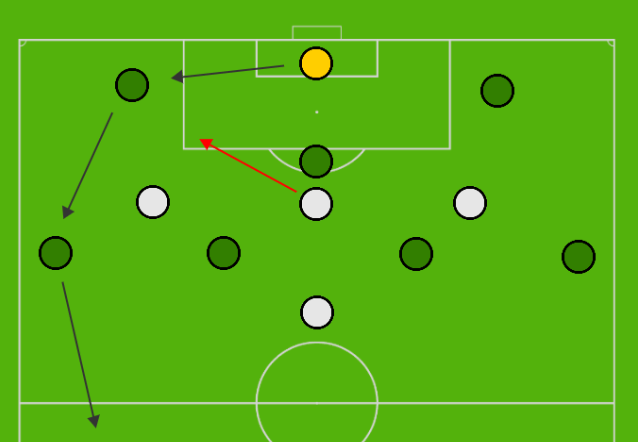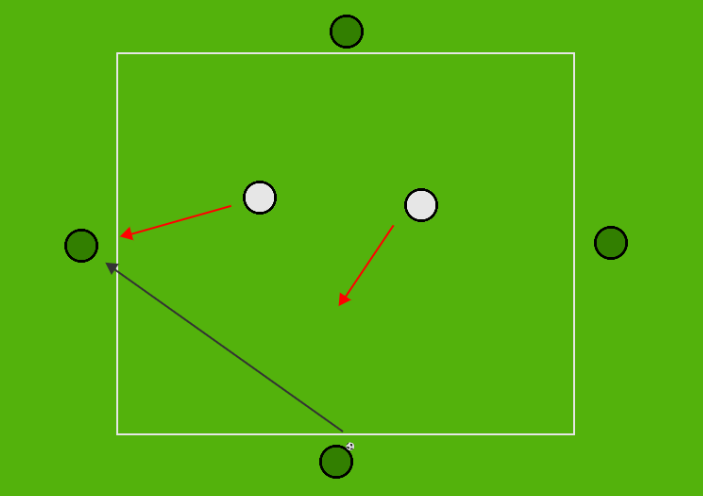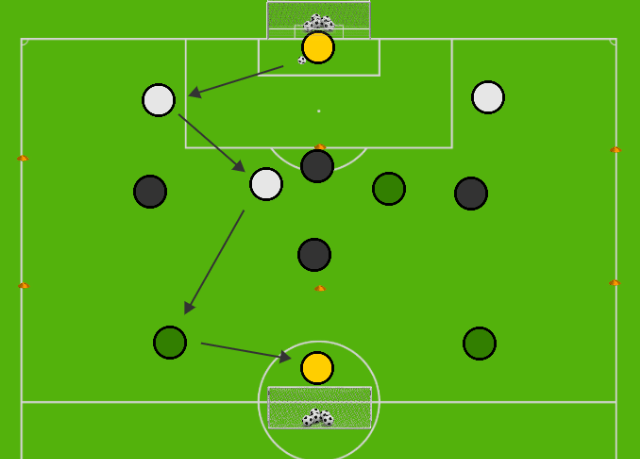
Playing out from the back is one of the most important elements of the modern game. Not only is it better for development than kicking it long, it is also easier and allows a team fewer risks at losing the ball. As a result, coaches of any age group should be looking to teach players young and old the necessary steps of playing out from the back. In order to help guide these coaches, we introduce a brand new session all about playing out from the back, for youth teams of any age.
warm-up: 4v2 rondo

Set-Up/Execution: Rondo with four players on the outside up and down a line, two on the inside. Team on the inside tries to regain possession. If they do, they go on the outside for the player that messed up and the player that passed them the ball. Focus is on making quick decisions in possession of the ball, working the ball around left to right under pressure.
Coaching Points:
– Avoid passing the ball to the player vertically across from you, unless absolutely necessary. Always see the wide options first.
– Movement up and down the line to receive.
– Quick transitions after losing possession. Pass to a teammate right away.
– Receive on the back-foot and take first touch away from pressure.
– One/two-touch play. Scan field to know next pass before receiving.
– Weight of pass. Part of foot.
activity 1: positional play

Setup/Execution: Green team sets up in your defensive shape, white team in your attacking shape. Green team has numerical advantage to keep possession. Focus is on playing out from the back using the goalkeeper and surrounding players, avoiding white team’s pressure and
trying to cross the halfway line to get a point. White team attempts to score on net if they win the ball. All restarts begin with the goalkeeper.
Coaching Points:
– As the ball goes out to one side, the far-sided defender shifts to the middle
– After the first pass, try to play forwards to the wings or central
midfielders. If it is not on, go backwards using the goalkeeper to switch play as other defender gets wide again.
– Central midfielders hover “in between the lines” of the opposition
(as pictured) to create space to receive. Shift across with the movement of the ball.
– Near-sided winger comes closer to the ball once played to the defender on their side.
progression: playing out with targets

Setup/Execution: Same as above but now adding in targets to score on, instead of dribbling across a line. The pictured set-up is a great alternate when playing with a back-three at 7v7 or 9v9. The centre-back reads the situation for the goalkeeper, going to one side. The goalkeeper plays to that side. Now the centre-back is a great backwards option if the fullback can not go
forwards. Note that the defensive midfielder has filled in the gap, while the other central midfielder remains between the lines to receive.
Coaching Points:
– If you cannot go forwards, go backwards to the centre-back. Then centre-back look to switch play, play a one-two with the fullback, or take space on the dribble.
– Read starting position of opposition press. If centre-back is the best
option for the first pass, use them first.
– After beating the opposition’s press, look to see if dribbling or passing is the best option based on space and positioning of teammates/opposition. Defenders move up with the play once out of the danger area.
activity 2: playing out 4+4 v 4

Setup/Execution: Green and White have three players in their defending zone + one in middle zone. These players are locked into their zones. Defending team (black) is not locked into their zone but must start there until the first pass is made from the goalkeeper. Black team presses from the front to win the ball back and try to score on either goalkeeper. White and green work together, playing out from the back, to pass the ball from one goalkeeper to the other. Rotate which team is the defending team. All restarts begin with the goalkeeper.
Coaching Points:
– When goalkeeper has the ball, defenders get low, close and wide.
– After receiving from goalkeeper, defender should look to go forwards but not force it if the right pass isn’t on. Instead go backwards using the goalkeeper to switch play. Do not make a pass across the middle in your own half, as it can be easily intercepted close to goal.
– Movement of the central midfielders (middle zone players) to create space.
game: restarts with goalkeeper

Setup/Execution: Game based on your numbers. Before starting, encourage players to huddle up and discuss a strategy of how they are going to play out from the back. This is an opportunity for the players to test their learning. Normal rules apply except all restarts begin with the goalkeeper.
Coaching Points:
– Let the players play. Minimal coaching and stoppages. Re-emphasize coaching points from the session, specifically starting positions, movement and communication.
– Ask players what their strategy was and whether or not they feel like they were successful.
So there it is! A session plan all about playing out from the back, guided towards helping your team work on their coolness under pressure, passing and moving, and ability to keep possession in their own end rather than kicking it long right to the other team! Be sure to share your thoughts on Twitter @mastermindsite and check out more of our Session Plans. Thanks for reading and see you soon!
More on Playing out from the Back…
-> Playing Out From The Back – The Basics
-> Playing out from the Back (9v9)
-> Playing Out From The Back – Session Plan and Key Coaching Points (2019)
-> Playing Forwards vs. Backwards – Session Plan and Coaching Tips


This site/blog or whatever it is, is like a gem for me.
Top top level contents every single time.
Thank you for your work!
LikeLike
Thank you Amin! Happy to hear that you are enjoying the content.
LikeLike